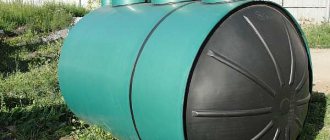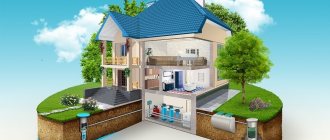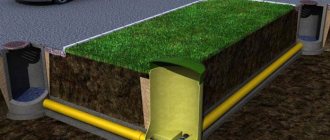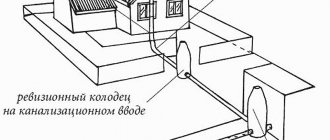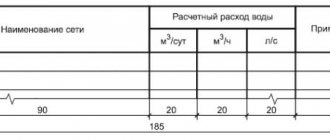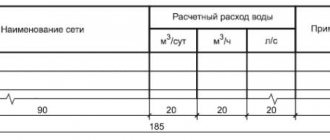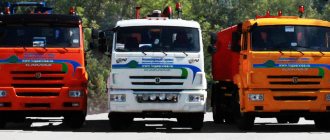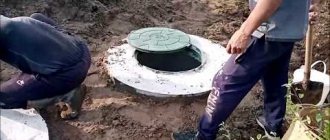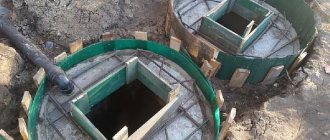Composition and distances from construction sites to utilities, i.e. security zones are defined in SNiP 2.07.01-89* , the current valid edition of this SNiP is SP 42.13330.2011. Actually from this SNiP it follows:
- Security zone for domestic sewerage
- Water pipeline security zone
- Security zone of heating networks
- Security zone of cables and communication networks
- Power line security zone
- Security zone of residential buildings and public buildings
- Protected zone of trees and shrubs
- Gas pipeline security zone
- Minimum distances between utilities
Water pipeline security zone
The security zone of the water supply system is 5 meters from the foundation of the facility to the network. The security zone from the foundation of the fence of enterprises, overpasses, contact and communication supports, railways to the water supply system is 3 meters.
In addition, from SP 42.133330.2011 Table 16 (see below for more details), you can glean the following information regarding the laying of water supply and sewer pipes:
"2. The distances from the domestic sewerage system to the drinking water supply should be taken, m: to the water supply system made of reinforced concrete and asbestos pipes - 5; to the water supply from cast iron pipes with a diameter of up to 200 mm - 1.5, with a diameter of over 200 mm - 3; to the water supply system made of plastic pipes - 1.5.
The distance between the sewerage networks and industrial water supply, depending on the material and diameter of the pipes, as well as the nomenclature and characteristics of the soil, should be 1.5 m.”
What is external sewerage
The meaning of “sewer protection zone” refers to external networks. This is a pipeline system through which domestic and industrial wastewater collected by internal drainage systems, as well as rain and melt water, are transported to pumping stations, and then to treatment facilities.
External sewer networks include:
- pipelines of various diameters
- wells: inspection wells
- differential
- rotary
When designing a sewer system, several significant factors are taken into account. Define:
- waste volume
- terms of Use
- distance to the nearest pumping station
- Possibility of connecting to an existing collector
- composition and properties of soils at the site of the proposed pipeline laying
- terrain
- groundwater level
- climatic conditions
- soil freezing index
Unlike the internal one, the external sewerage system is operated under more severe conditions. In addition to the impact of wastewater on the inner surface of the pipes, they are influenced from the outside by external factors - wet soil, aggressive environment, temperature changes. Installation of external sewerage is carried out from metal, plastic, as well as concrete and asbestos-cement pipes.
The sewer system diagram can be:
- separate - separate installation of rain and domestic sewerage
- semi-separate - separate collection of rainwater and domestic wastewater with further transportation in a common collector
- common - joint sewerage system
When designing and laying utility networks, you must adhere to the mandatory requirements of SNiP. Properly completed work on laying the external sewerage network will be the key to its long-term and trouble-free operation.
Power line security zone
The current rules for determining the security zone for power lines are determined in accordance with Decree No. 160 of the Government of the Russian Federation dated February 24, 2009. And in general, they say that the security zone for overhead power lines is a vertical plane at a given distance from the outermost wires of the power line.
The distance itself varies depending on the line power and is defined in the Appendix. According to paragraph a) of this appendix, for overhead lines, depending on the power, they will be:
| up to 1 kW | up to 12 meters |
| 1-20 kW | 10 meters |
| 35 kW | 15 meters |
| 110 kW | 20 meters |
| 150-220 kW | 25 meters |
| 300-500 kW | 30 meters |
| 750 kW | 40 meters |
| 1150 kW | 55 meters |
However, according to the same paragraph, if power lines are laid within the boundaries of populated areas under the sidewalk then:
- up to 1 kW, the permissible security zone from the outermost wires is 0.6 meters to the foundation of the building and 1 meter to the roadway.
- For lines over 1 and up to 20 kW, the security zone will be 5 meters .
According to the same annex, in places where power transmission lines cross navigable rivers , the security zone for them will be 100 meters . For non-navigable rivers, protection zones do not change.
In the security zones of power lines, a special land use procedure has been defined. Within the security zones, the land is not seized from the owner, but encumbrances are imposed on its use - do not build, do not store, do not block, do not hammer piles, do not drill pits, carry out work using heavy equipment only in agreement with the Network Organization, etc. P. for more details, see the resolution.
Security zones, although determined according to the application, are ultimately established by the owner of the networks , information about them is transmitted to the cadastral chamber. Paragraph 7 of the resolution states that the network organization must, at its own expense, place information about the presence, danger, and size of security zones, in these very zones - i.e. install appropriate information signs.
Limitations and their reasons
Almost no work can be carried out in the sewerage area. If something needs to be done, it must be agreed upon.
Wells in the country
Well, if the territory is entirely private, it is still worth consulting with an engineer. Do not forget that even when owning a plot of land, the owner is responsible for its condition.
And this is normal, because in the Earth’s ecosystem everything is dependent on each other. If an infestation occurs in one place, it will affect nearby areas.
The cycle of substances in nature is of global importance. A sewerage system that breaks somewhere will affect the ecosystem as a whole, even if it is almost unnoticeable.
Pressure system repair
If we talk about the consequences near the accident and the sewer protection zone, they are by no means inconspicuous. This leads to problems for the environment, and therefore for people. The consequences also negatively affect surrounding buildings, communications, including the water supply.
Gas pipeline security zones
Decree of the Government of the Russian Federation dated N 878 (ed. from ) “On approval of the Rules for the protection of gas distribution networks” Clause 7. The following security zones are established for gas distribution networks: a) along the routes of external gas pipelines - in the form of a territory limited by conditional lines running at a distance of 2 meters on each side of the gas pipeline; b) along the routes of underground gas pipelines made of polyethylene pipes when using copper wire to mark the gas pipeline route - in the form of an area limited by conditional lines running at a distance of 3 meters from the gas pipeline on the side of the wire and 2 meters on the opposite side; c) along the routes of external gas pipelines on permafrost soils , regardless of the pipe material - in the form of an area limited by conditional lines running at a distance of 10 meters on each side of the gas pipeline; d) around separate gas control points - in the form of a territory bounded by a closed line drawn at a distance of 10 meters from the boundaries of these objects. For gas control points attached to buildings, the security zone is not regulated; e) along underwater crossings of gas pipelines through navigable and floating rivers , lakes, reservoirs, canals - in the form of a section of water space from the water surface to the bottom, enclosed between parallel planes spaced 100 m on each side of the gas pipeline; f) along the routes of inter-settlement gas pipelines passing through forests and trees and shrubs - in the form of clearings 6 meters wide, 3 meters on each side of the gas pipeline. For above-ground sections of gas pipelines, the distance from trees to the pipeline must be no less than the height of the trees throughout the entire life of the gas pipeline.
Liability for violations
Violating the rules regarding the security zone of such a system is a crime. And according to the law, the violator bears responsibility.
Utility pipeline
The extent of this depends on how much damage was caused. Its dimensions are also being assessed by employees of the sanitary and epidemiological station.
It’s one thing if the fact of violation of the security zone is simply established and nothing has happened yet, and another thing if people got sick or died because of this.
Of course, the level of responsibility will vary. In the first case - administrative (Article 7, paragraph 7), in the second - criminal. But there will be responsibility in any case.
Gravity system
Where the sanitary zone of the sewage treatment plant was violated also plays a big role. If this is a residential building in a city or other locality, the level of liability is higher compared to the private sector or, especially, a lonely private house. But to get an idea of how much you will have to pay, it is important to periodically check the laws.
It is possible that the sewer area will change over time. But it is unlikely that it will decrease; rather, on the contrary. At least, this should ideally be the case according to the logic of protecting the environment and people. After all, cleanup measures do not always help to completely eliminate the consequences of an accident if the network is poorly placed.
Installation of pressure pipeline
If you need to individually install a protective territory for a domestic sewer network in each direction on your land plot, it is important to make sure that the engineer has permission to do this. Even if a specialist has the proper qualifications, but this is not confirmed, then in the event of an accident, claims will be against the owner of the land.
Minimum distances of gas pipelines.
Gas pipelines are distinguished by design (overground, underground), pressure inside the pipe (from several kilopascals to 1.5 megapascals) and pipe diameter. The distance from the gas pipeline to the building is determined in SP 62.13330.2011 in Appendix B. Here are excerpts from this application for underground and aboveground gas pipelines.
Summary
Land owners are required to pay attention to drawing up a thorough plan for the wastewater system, as well as to accurately implementing the finished project on the ground. It is also important to remember about decree number 578, aimed at coordinating the boundaries within which the telephone sewer security zone runs. This distance must be at least two meters on both sides.
If the state inspection reveals violations, the owner of the site will be obliged to carry out conversion work. Naturally, relocating the sewer system will result in serious financial expenses. And it is not always possible to do such work technically.
Everything useful about sewerage -
GidKanal | Yandex Zen
Annex 1
Recommended
Drinking water supply research program
1. Underground springs
1.1. Geological structure of the area where the source is located and general characteristics of its hydrogeological conditions; type of selected aquifer (artesian - confined, ground - unconfined), depth (absolute elevation) of the roof of the aquifer, thickness, water-bearing rocks (sands, gravel, fractured limestones); conditions and places of recharge and discharge of the aquifer; general information about the water abundance of the horizon (operational reserves); information on the current and future use of the aquifer for water supply and other purposes.
1.2. General information about the hydrogeological conditions of the area (field), recharge conditions of aquifers proposed for use for water supply, topographic, soil and sanitary characteristics of the water intake area, characteristics of the aquifer planned for exploitation (lithological composition, thickness, protection of the aquifer by overburden rocks, dynamic water level at calculated water withdrawal).
1.3. Data on the water permeability of layers, overlying layers, data on the possibility of influence of the recharge zone on water quality.
1.4. Sanitary characteristics of the area directly adjacent to the water intake; distance from the water intake to possible sources of water pollution: abandoned wells, absorption craters, sinkholes, wells, abandoned mine workings, storage tanks, etc.
2. Surface sources
2.1. Hydrological data: drainage basin area, surface flow regime, maximum, minimum and average flow rates, speed and water level at the point of water intake, average periods of freeze-up and break-up, estimated flow rate of water used and its compliance with the minimum flow rate at the source, data on the characteristics of tidal currents.
2.2. General sanitary characteristics of the pool in that part of it that can affect the quality of water at the water intake:
• the nature of the geological structure of the basin, soil, vegetation, presence of forests, cultivated lands, populated areas;
• industrial enterprises (their number, size, location, nature of production);
• reasons that influence or may influence the deterioration of water quality in a water body, methods and places for disposal of solid and liquid waste in the area where the source is located; the presence of domestic and industrial wastewater that pollutes the reservoir, the amount of wastewater discharged, facilities for its treatment and their location;
• distance from the wastewater discharge point to the water intake;
• the presence of other possible causes of source pollution (shipping, timber rafting, watering, winter dumps on ice, swimming, water sports, reclamation work, use of fertilizers and pesticides in agriculture, etc.).
2.3. Characteristics of the self-cleaning ability of a reservoir.
2.4. For reservoirs, in addition, the following is indicated:
• surface area and volume of the reservoir, useful and “dead” volume, feeding and use regime, water release in the reservoir, layout of the reservoir, its maximum and minimum depth, nature of the bottom, banks, bottom sediments, presence of blooms, overgrowth, siltation, direction of dominant winds and currents, the speed of water movement in the reservoir.
3. General information
3.1. Data on the possibility of organizing a sanitary protection zone for a water supply source, approximate boundaries of the sanitary protection zone for its individual belts.
3.2. Data on the need to treat source water (disinfection, clarification, deferrization, etc.).
3.3. Data on adjacent water intakes having the same supply area (location, productivity, water quality).
General concepts
Sewer protection zones are areas that surround sewer network structures, bodies of water and airspace, where in order to provide protection to sewer systems, the use of certain actions or immovable objects is limited.
In such areas, it is necessary to refrain from such actions that contribute to harm to the structures of the sewer system:
- plant trees;
- obstruct passage to communication structures of the outlet network;
- produce a warehouse of materials;
- engage in construction, mining, blasting, piling work;
- carry out lifting work near buildings without the permission of the owner of the sewer network;
- carry out near networks located near water bodies, moving soil, dredging the bottom, immersing solids, pulling logs, chains, anchors of water vehicles.
The security zone + sewerage have their own boundary limits, which are set taking into account:
- location;
- appointments;
- diameter of buildings;
- gasket depth.
As a rule, boundaries are prescribed in a decree issued by the Minister of the Environment, but exact information can be obtained from local governments or water and sewerage organizations.
Installation of belt boundaries of water basins under the ground
For the 1st belt, SanPiN 2.1.4.1110-02 establishes the following boundary standards:
Zones for water intake from underground water horizons must be located outside the territorial boundaries of production and residential buildings.
The distance from the water intake source to the final boundary of the 1st belt is taken to be no less than:
- 30 m when operating a well-protected underground water basin;
- 50 m – in the absence of protection of the underground water horizon.
The 1st belt must end at a distance of at least 30 and 50 m, respectively, for protected and unprotected extreme well sources.
Protected water basins include, with or without pressure, water basins located between layers of soil, having a waterproof roof that prevents water from the upper aquifers from penetrating into the water horizon.
Water sources with insufficient underground protection include:
- pools located in the 1st aquifer, while filling with surface groundwater occurs throughout their entire area;
- under pressure and without pressure, water pools into which water penetrates from the upper layers through water biological windows, permeable roofing, from water pools and streams through interaction according to the laws of hydraulics.
When operating underground water intake horizons with artificial filling of water resources, the boundary of the 1st strip is taken to be no less than 50 m from the water intake zone and no less than 100 m from filtering engineering objects (pools, canals).
When the distance between the point of water intake and the reservoir is less than 150 m, the border of the 1st zone includes the coastal zone.
Borders of the 2nd and 3rd zones. When determining them, the following factors are taken into account:
- type of water intake sources (individual, group or linearly located wells, horizontal drainage channels);
- the volume of water intake taking into account the decrease in its static level in the underground pool;
- nutrition, drainage and features of the hydrology of the water basin.
The boundaries of the 2nd zone are determined by mathematical calculations according to the rules of hydrodynamics, taking into account that if the territory is contaminated by microbes outside it, the contamination should not reach the water intake basin.
The territory of the 3rd zone for the protection of water basins from pollution by chemical reagents is also established by calculation methods using hydrodynamic formulas. The formulas are used to calculate the time it takes for harmful chemicals to move to the water intake basin, taking into account that it should be less than the operating life of the source (from 25 to 50 years).
If the operational life of the water intake is unlimited, the territory of the 3rd zone is increased beyond the standard for long-term operation of the water basin without the possibility of contamination.
Rice. 7 Climatic regions
Responsibilities of the work producer
Working sewer systems are the key to good life support for city citizens, therefore, when carrying out work in the protected zone, the organizer of this work is obliged to:
- adhere to strict adherence to rules and regulations;
- ensure through their actions the safety and integrity of sewerage structures in the work area;
- in case of detection of inconsistencies in kind with the analysis provided by the water supply and sewerage organizations, take precautionary measures and suspend the work until a further decision;
- remove snow, ice, and debris in a timely manner to ensure free access to sewerage facilities;
- When handing over the object, invite a representative of the body that issued the permit to the commission.
These measures apply to producers operating in open areas.
Rules for the protection of main pipelines
The arrangement of main pipelines must comply with the provisions of Resolution No. 9 of the Gosgortekhnadzor of Russia dated April 24, 1992, “Rules for the protection of main pipelines.” This decree prescribes security zones for various types of main pipelines. For objects of various purposes, their own protection zone regime is determined, which contains restrictions regarding the land plot adjacent to the place of use.
Objects with open and underground water supply sources have sanitary zones, for which the boundaries are set taking into account the soils of the underground areas. Water supplies for various facilities must be planned and developed simultaneously with sewerage projects.
Sanitary protection zone (Design of sanitary protection zones)
Watch this video on YouTube
According to the rules in the security zone it is prohibited:
- unauthorized planting of trees;
- digging holes and trenches;
- storage and dumping of garbage, firewood, and other materials;
- performing pile driving work;
- carrying out blasting operations;
- earthworks for various purposes related to the movement of soil;
- equip permanent or temporary road surfaces from reinforced concrete slabs;
- carry out work blocking access to water supply and sewerage pipelines.
Dimensions of protected areas
According to SNiP, protective zoning of water supply facilities is formed from 3 zones:
- Strict regime.
- Restrictive.
- Observant.
Sanitary belt No. 1 is responsible for protecting water intake sites and structures for this purpose from any actions that could cause harm. Belt No. 2 protects water sources from microbiological contamination. Observation belt No. 3 monitors the level of chemical pollution. According to hygienic standards, sanitary zoning for open and underground water supply sources has different sizes.
The strict regime open source belt is determined by adding 200 m of adjacent territory upstream and 100 m downstream. For underground sources, belt No. 1 is no less than:
- 50-60 m around small wells;
- 25 m for deep wells.
The 2nd and 3rd zones of the sanitary protection zone are determined by specialists using a complex method using hydrodynamic calculations. They take into account the survival time of microbes for the restrictive belt. For observational zoning, the range of distribution of chemical compounds, while their composition in water is considered stable.
What does violating norms and requirements lead to?
Punishment for non-compliance with the rules of sanitary zoning of water supply networks is regulated by the Code of the Russian Federation “On Administrative Violations” dated December 30, 2001 No. 192-FZ. Contamination of water sources and areas of sanitary protection belts can lead to contamination of drinking water. And this, in turn, can cause the spread of epidemics and mass diseases of people. Penalties apply to:
- individuals (citizens);
- officials;
- legal entities (firms and companies).
Administrative liability for non-compliance with the rules and requirements for sanitary water supply areas is as follows - sanctions are imposed on those responsible in the form of a fine:
- for a private person - 500-1000 rubles;
- officials - 1000-2000 rubles;
- firms and companies - 10-20 thousand rubles.
3.2. Activities on the territory of the WSS of underground water supply sources*
3.2.1. Events in the first zone
3.2.1.1. The territory of the first zone of the ZSO must be planned to divert surface runoff beyond its boundaries, landscaped, fenced and provided with security. Paths to structures must have a hard surface
_________
* The purpose of the measures is to maintain the constancy of the natural composition of water in the water intake by eliminating and preventing the possibility of its pollution.
3.2.1.2. It is not allowed: planting tall trees, all types of construction that are not directly related to the operation, reconstruction and expansion of water supply facilities, incl. laying pipelines for various purposes, placement of residential and utility buildings, human habitation, use of pesticides and fertilizers.
3.2.1.3. Buildings must be equipped with a sewerage system with wastewater discharge to the nearest domestic or industrial sewerage system or to local wastewater treatment plants located outside the first zone of the ZSO, taking into account the sanitary regime in the territory of the second zone.
In exceptional cases, in the absence of a sewerage system, waterproof sewage and household waste receptacles should be installed, located in places that prevent contamination of the territory of the first belt of the SSS during their removal.
3.2.1.4. Water supply facilities located in the first zone of the sanitary protection zone must be equipped to prevent the possibility of contamination of drinking water through the heads and mouths of wells, hatches and overflow pipes of tanks and pump filling devices.
3.2.1.5. All water intakes must be equipped with equipment for systematic monitoring of the compliance of the actual flow rate during the operation of the water supply system with the design capacity provided for during its design and justification of the boundaries of the SZZ.
3.2.2. Events for the second and third belts
3.2.2.1. Identification, plugging or rehabilitation of all old, inactive, defective or improperly operated wells that pose a risk of potential contamination of aquifers.
3.2.2.2. Drilling of new wells and new construction associated with soil disturbance is carried out with mandatory approval from the center of state sanitary and epidemiological surveillance.
3.2.2.3. Prohibition of pumping waste water into underground horizons, underground storage of solid waste and mining of the earth's subsoil.
3.2.2.4. Prohibition of the placement of warehouses for fuels and lubricants, pesticides and mineral fertilizers, industrial waste storage tanks, sludge storage facilities and other objects that pose a risk of chemical pollution of groundwater.
The placement of such objects is allowed within the third zone of the Western Zone only when using protected groundwater, subject to the implementation of special measures to protect the aquifer from pollution in the presence of a sanitary and epidemiological conclusion from the center of state sanitary and epidemiological supervision, issued taking into account the conclusion of geological control authorities.
3.2.2.5. Timely implementation of the necessary measures for the sanitary protection of surface waters that have a direct hydrological connection with the used aquifer, in accordance with the hygienic requirements for the protection of surface waters.
3.2.3. Events for the second belt
In addition to the measures specified in section 3.2.2, the following additional measures must be carried out within the second zone of the ZSO of underground water supply sources.
3.2.3.1. Not allowed:
• placement of cemeteries, cattle burial grounds, sewage disposal fields, filtration fields, manure storage facilities, silo trenches, livestock and poultry farms and other objects that pose a risk of microbial contamination of groundwater;
• use of fertilizers and pesticides;
• felling of forests for general use and reconstruction.
3.2.3.2. Implementation of measures for sanitary improvement of the territory of settlements and other objects (equipment of sewerage, installation of waterproof cesspools, organization of drainage of surface runoff, etc.).
Specifics of prohibitions within the boundaries of ZSanO
The most stringent requirements are imposed on strict security zones (the first zone). On their territories it is forbidden to erect buildings and structures, dig trenches or otherwise go deep into the ground, store any materials, apply fertilizers, litter, cut down green spaces, graze livestock, go fishing, arrange moorings for boats, or swim.
Prohibition signs are attached next to the warning sign, indicating what is strictly forbidden to do in the sanitary protection zone
An extensive list of prohibitions has also been compiled for the second security zone. Construction and blasting work, driving piles and other actions that create vibration are prohibited. You cannot dump wastewater, develop the bowels of the earth, cut down forests, place warehouses for pesticides, fertilizers, fuels and lubricants, plow up virgin lands, or drain swamps.
It is not allowed to allocate space for cattle burial grounds, silage and manure pits, livestock and poultry breeding complexes, etc. The use of the protected area for living, active recreation, and sporting events is prohibited. It is prohibited to pull water pipelines through landfills, filtration fields, or near cemeteries.

